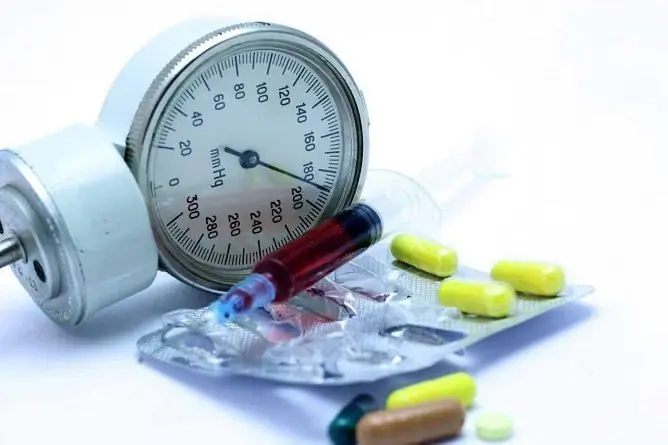Table of contents:
- Trigamma
- Release form and composition
- Pharmacological properties
- Indications for use
- Contraindications
- Instructions for use of Trigamma: method and dosage
- Side effects
- Overdose
- special instructions
- Application during pregnancy and lactation
- Pediatric use
- Drug interactions
- Analogs
- Terms and conditions of storage
- Terms of dispensing from pharmacies
- Reviews about Trigamma
- Price for Trigamma in pharmacies

Video: Trigamma - Instructions For Use, Price, Reviews, Analogues

2024 Author: Rachel Wainwright | [email protected]. Last modified: 2023-12-15 07:39
Trigamma
Trigamma: instructions for use and reviews
- 1. Release form and composition
- 2. Pharmacological properties
- 3. Indications for use
- 4. Contraindications
- 5. Method of application and dosage
- 6. Side effects
- 7. Overdose
- 8. Special instructions
- 9. Application during pregnancy and lactation
- 10. Use in childhood
- 11. Drug interactions
- 12. Analogs
- 13. Terms and conditions of storage
- 14. Terms of dispensing from pharmacies
- 15. Reviews
- 16. Price in pharmacies
Latin name: Trigamma
ATX code: N07XX
Active ingredient: pyridoxine (pyridoxinum) + thiamine (thiamine) + cyanocobalamin (cyanocobalamin) + lidocaine (lidocainum)
Manufacturer: Moskhimfarmpreparaty them. ON. Semashko (Russia)
Description and photo update: 2018-21-11

Trigamma is a complex preparation of B vitamins, which normalizes metabolic processes, local anesthetic, anti-inflammatory and metabolic effects.
Release form and composition
Dosage form of Trigamma - solution for intramuscular administration: red transparent liquid (in 1 ampoule 2 ml of solution, in a cardboard box 1 or 2 pallets of 5 ampoules).
Composition of 1 ml solution:
- active substances (in terms of anhydrous substance): cyanocobalamin - 0.5 mg; pyridoxine hydrochloride - 50 mg; thiamine hydrochloride - 50 mg; lidocaine hydrochloride - 10 mg;
- additional components: benzethonium chloride, edetate disodium (Trilon B), sodium hydroxide, water for injection.
Pharmacological properties
Pharmacodynamics
Trigamma includes a complex of B vitamins. Neurotropic vitamins of this group have a beneficial effect on degenerative and inflammatory diseases of the locomotor system and nerves.
The main properties of the Trigamma components:
- vitamin B 1 (thiamine): essential for carbohydrate metabolism, which is critical in the metabolic processes of the nervous tissue, as well as in the Krebs cycle, followed by participation in the synthesis of ATP and TPP (adenosine triphosphate and thiamine pyrophosphate). Thiamine of all vitamins is stored in the body in the smallest amount. Due to the lack of its significant reserves, vitamin B 1 must be present in the diet daily. The tissues and organs of an adult contain about 30 mg of thiamine in the form of thiamine pyrophosphate, thiamine triphosphate and thiamine monophosphate (80, 10 and 10%, respectively);
- vitamin B 6 (pyridoxine): takes part in the metabolism of proteins and, in part, in the metabolic processes of fats and carbohydrates. The tissues and organs of an adult contain from 40 to 150 mg of vitamin B 6; thiamine and pyridoxine potentiate each other's action, as a result of which they have a positive effect on the nervous, cardiovascular and neuromuscular systems;
- vitamin B 12 (cyanocobalamin): takes part in the synthesis of the myelin sheath, reduces the severity of pain sensations associated with damage to the peripheral nervous system, stimulates hematopoiesis and nucleic acid metabolism by activating folic acid;
- lidocaine: has a local anesthetic effect.
Pharmacokinetics
The main pharmacokinetic characteristics of thiamine:
- absorption: after intramuscular injection from the injection site, it is rapidly absorbed and enters the bloodstream. Cmax (maximum concentration of the substance) is reached on the first day 15 minutes after administration of 50 mg and is 484 ng / ml;
- distribution: uneven, content in erythrocytes - 75%, leukocytes - 15%, blood plasma - 10%. Penetrates the blood-brain and placental barriers and is excreted in breast milk;
- metabolism: the main metabolites of thiamine are pyramine, thiamincarboxylic acid and some unknown metabolites;
- excretion: excreted in the α-phase by the kidneys after 0.15 hours, in the β-phase - after 1 hour, in the terminal phase - within 2 days.
The main pharmacokinetic characteristics of pyridoxine:
- absorption and distribution: after intramuscular administration, it enters the systemic circulation quickly. Acting as a coenzyme after phosphorylation of the CH 2 OH group in the fifth position, it is distributed in the body. Binds to blood plasma proteins approximately 80% of the dose. Distributed throughout the body, penetrates the placental barrier, excreted in breast milk;
- metabolism and excretion: deposited in the liver and oxidized to 4-pyridoxinic acid. A maximum of 2-5 hours after absorption, it is excreted in the urine. The daily rate of elimination of pyridoxine is from 1.7 to 3.6 mg with a replacement rate of approximately 2.2–2.4%.
The main pharmacokinetic characteristics of cyanocobalamin:
- absorption and distribution: after subcutaneous and intramuscular administration, Cmax is reached after 60 minutes. In the blood, it binds to transcobalamins I and II, which transport it to tissues. The connection with plasma proteins is 90%. Penetrates the placental barrier, excreted in breast milk;
- excretion: deposited mainly in the liver, after which it is excreted into the intestines with bile and again absorbed into the blood. T 1/2 (half-life) is 500 days. Excretion with normal / reduced renal function: with urine - 7-10% / 0-7%, through the intestines - about 50% / 70-100%.
The main pharmacokinetic characteristics of lidocaine:
- absorption and distribution: Cmax of lidocaine in blood plasma with intramuscular administration is achieved in 5-15 minutes. Plasma proteins bind 50–80% of the dose. There is a rapid distribution (over 6-9 minutes) in organs and tissues with good perfusion, including in the lungs, heart, kidneys, liver, then in adipose and muscle tissue. Penetrates through the blood-brain and placental barrier, excreted in breast milk (from the concentration in the mother's plasma - up to 40%);
- metabolism and excretion: metabolism occurs primarily in the liver (90–95% of the dose) with the participation of microsomal enzymes. Active metabolites are formed - monoethylglycinexylidide and glycinexylidide, their T 1/2 is 2 and 10 hours, respectively. With liver disease, the metabolic rate decreases. Excretion occurs in urine and bile (unchanged - up to 10%).
Indications for use
According to the instructions, Trigamma is prescribed as part of the complex treatment of the following neurological diseases:
- neuritis, including retrobulbar neuritis;
- paresis of the facial nerve;
- polyneuropathy, including diabetic, alcoholic;
- herpes zoster;
- neuralgia;
- radicular syndromes;
- myalgia.
Contraindications
- decompensated heart failure;
- age up to 18 years;
- pregnancy and the period of breastfeeding;
- individual intolerance to the components of Trigamma.
Instructions for use of Trigamma: method and dosage
Trigamma is injected deeply intramuscularly.
With severe pain syndrome, 2 ml is prescribed daily for 5-10 days. After that, the patient is transferred to oral dosage forms or the frequency of use of Trigamma is reduced (2-3 times a week for 2-3 weeks).
Side effects
- allergic reactions: itching, urticaria; in some cases - symptoms of hypersensitivity to Trigamma, including shortness of breath, rash, anaphylactic shock, angioedema;
- others: in some cases - acne, tachycardia, increased sweating.
Overdose
The main symptoms of an overdose: with a very rapid administration of Trigamma, systemic reactions (in the form of dizziness, arrhythmias, convulsions) can develop, and they can also be the result of exceeding the dose.
Therapy: symptomatic.
special instructions
There is no information.
Application during pregnancy and lactation
It is not recommended to use trigamma during pregnancy / lactation.
Pediatric use
Trigamma is not prescribed for patients under 18 years of age (due to the limited experience of use).
Drug interactions
Possible interactions:
- thiamine: undergoes complete decomposition in solutions that contain sulfites; in the presence of decay products of vitamin B 1, other vitamins are inactivated; accelerates the destruction of thiamine copper; with an increase in pH values (more than 3), thiamine loses its effect;
- pyridoxine: in Parkinson's disease, accelerates the decarboxylation of levodopa in tissues, which leads to a decrease in its effectiveness;
- vitamin B 12: pharmaceutically incompatible with salts of heavy metals and ascorbic acid;
- lidocaine: when used in combination with epinephrine and norepinephrine, side effects on the heart may increase.
Analogs
Analogs of Trigamma are Compligam B, Vitagamma, Vitaxon, Milgamma, Binavit.
Terms and conditions of storage
Store in a dark place at a temperature of 0-8 ° C. Keep out of the reach of children.
Shelf life is 2 years.
Terms of dispensing from pharmacies
Dispensed by prescription.
Reviews about Trigamma
According to reviews, Trigamma is prescribed as an additional agent with an analgesic and metabolic-improving effect. In general, the drug is assessed by patients as effective. The development of side effects is reported in extremely rare cases.
Price for Trigamma in pharmacies
The approximate price of Trigamma solution for intramuscular administration for a package of 5 ampoules of 2 ml is 117 rubles.

Maria Kulkes Medical journalist About the author
Education: First Moscow State Medical University named after I. M. Sechenov, specialty "General Medicine".
Information about the drug is generalized, provided for informational purposes only and does not replace the official instructions. Self-medication is hazardous to health!
Recommended:
Spring Adonis - Properties, Indications For Use, Reviews

Adonis is a herbaceous plant from the genus of buttercups. The pharmaceutical industry produces on the basis of adonis tincture and tablets of Adonizid, which are prescribed for cardiac neurosis, vegetative vascular dystonia, etc
Azitrox - Instruction, Use For Children, Price, Suspension, Capsules

Instructions for use Azitrox suspension and capsules. Information on dosing for children, contraindications, reviews, analogues and the price of the drug in pharmacies
Nicotine Patch - Price, Reviews, Indications

Nicotine patch is an effective remedy for weaning from nicotine addiction
Stopdiar - Instruction, Application For Children, Price, Reviews, Suspension

Instructions for use of Stopdiar in the form of a suspension, capsules and tablets. Information on doses for children, contraindications, reviews, analogues and the price of the drug in pharmacies
Erispirus - Instruction, Use For Children, Price, Tablets, Syrup

Instructions for use Erispirus tablets and syrup. Information on the dosage for children, contraindications, reviews, analogues and the price of the drug in pharmacies






